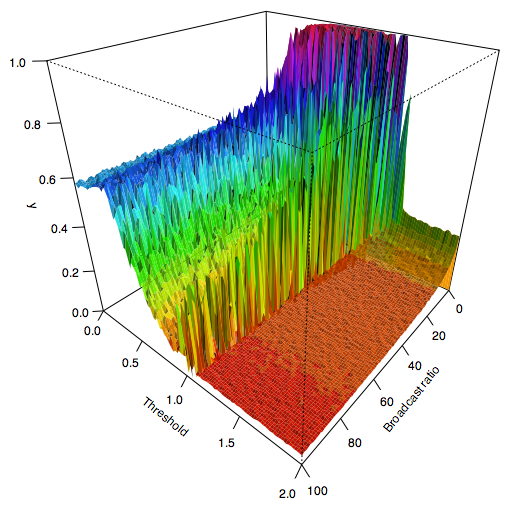Irreversibility in Wicked Problems
 Cumulative Effects
Cumulative EffectsBy J.B. Ruhl
In my last post I outlined the characteristics of some cumulative effects problems that make them particularly difficult to predict and manage--i.e., wicked problems. These are: (1) massive agent numbers; (2) nonlinear aggregation thresholds; (3) agent resistance to change ("roots"); and (4) interaction with other systems ("tentacles"). In this series of posts I explore reasons why managing such problems through either heavy reliance on property rights and markets or heavy reliance on command-and-control regulation driven by cost-benefit analysis is problematic in the long run.
Before diving into an analysis of those two management options, it is useful to think about what is going on inside wicked problems. Although I have used human impact on ecological systems as my theme so far, the wicked problem characteristics discussed in the last post and the model I'll develop here strike me as describing a host of human-system phenomena, such as human migration (as suggested to me by my colleague Leslie Wexler), terrorism, globalization of economies, poverty, distribution of health care, and so on.
So take Ecosystem as an example. Ecosystem is a conglomerate of biological and physical processes interacting to produce what we identify as a discrete unit of nature--e.g., the Everglades, a rainforest, a watershed. The processes within Ecosystem, however, are operating on many different temporal and geographic scales. Annual grasses and redwoods have different time scales. Top level predators and ants have different geographic scales. Ecosystem is defined by the interaction of these fast-slow and large-small processes--how they fit together, how changes in one affect others, how they respond to stress (for a nice description of the fast-slow/large-small processes model see Panarchy by Lance Gunderson & C.S. Holling). Ecosystem exists in an environment of (for our purposes) exogenous forces that make up a disturbance regime--floods, fires, droughts, etc--to which different processes in Ecosystem are adapted. A drought might knock back annual grasses for a while, but with the first good rain they bounce back. A major fire might clear out understory of the forest, but also trigger the release of seeds from large tree species.
This all works fine--meaning Ecosystem trucks along in a state of ordered disequilibrium--so long as the disturbance regime itself remains within a relatively stable range of behavior. But what happens when it doesn't? For example, what if humans move into Ecosystem and start suppressing fire, withdrawing groundwater, and introducing species, with gradually more humans adding to these and other actions? Or what happens if the earth's tilt changes, as it has in the past, and climate change gradually sets in?
These new disturbance forces inevitably put stress on the resilience Ecosystem's complex web of processes has built up to the perturbations to which it was adapted. If we were to observe the effects on Ecosystem of this additional (and qualitatively different) source of stress, we'd likely first see changes in fast-small processes with little or no apparent effect on the slow-large processes. But there is an effect on the slow-large processes, it's just that it builds up over time, and the accumulation of effects in fast-small processes contributes to the cumulative effect. By the time effects on slow-large processes can be observed, however, it's possible that a nonlinear threshold has been passed--the invasive species has its foothold, the lack of water begins to take its toll on large woody vegetation, soil begins eroding rapidly, top predators die out, etc.
The problem with nonlinear thresholds--what makes them wicked--is that once you cross one, it is not that easy to turn around and rewind the system to get back to the other side. In fact, it's usually impossible in any time frame that we care about. Once the invasive species is "in," it's a heck of a time to get it "out," and once the mature forest tree species die or are removed, it takes a long time for them to come back, which may never happen if all the soils erode in the meantime (take a look a Madagascar for an example). Indeed, push hard enough on enough nonlinear thresholds and what we thought of as Ecosystem is henceforth for all practical purposes an entirely new ecological process assembly--it's Ecosystem II.
To be sure, in some cases the "no going back" effect is a good thing from an anthropocentric perspective--the new system may be normatively better. Certianly plenty of technological changes have pushed human societies and economies "forward" through previously inpenetrable barriers, on balance for the good. But it's often more of a mixed bag, sometimes decidedly negative, and we can't pick and choose when the thresholds appear and what the other side looks like.
So, in addition to the four characteristics of wicked problems model covered in the previous post, add irreversibility to the list. Next I will explore how successful the two management extremes--unrestrained markets versus cost-benefit regulation--are likely to be to defy this inherent challenge.
















